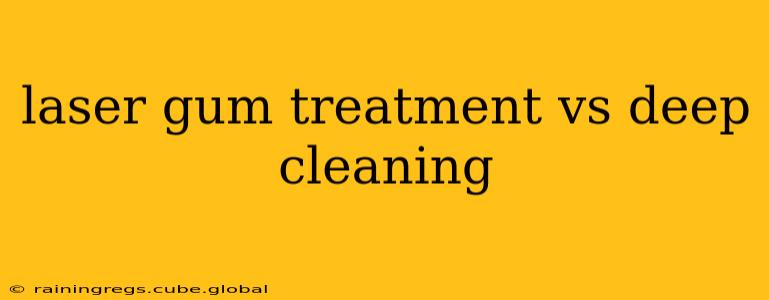Gum disease, or periodontal disease, is a serious infection that affects the gums and supporting structures of the teeth. If left untreated, it can lead to tooth loss. Two common treatments for gum disease are laser gum treatment and deep cleaning (also known as scaling and root planing). Understanding the differences between these procedures is crucial in choosing the best approach for your oral health.
What is Laser Gum Treatment?
Laser gum treatment uses a laser to precisely target and remove infected gum tissue. The laser's heat sterilizes the area, promoting faster healing and reducing discomfort compared to traditional methods. This minimally invasive procedure is often used to treat gingivitis (early gum disease) and periodontitis (advanced gum disease). The laser's precision allows for targeted treatment, minimizing damage to healthy gum tissue.
Advantages of Laser Gum Treatment:
- Minimally invasive: Less tissue is removed compared to traditional surgery.
- Reduced bleeding and discomfort: The laser cauterizes blood vessels as it works, minimizing bleeding and post-operative pain.
- Faster healing time: Patients often experience quicker recovery and return to normal activities sooner.
- Improved precision: The laser allows for more accurate targeting of infected tissue.
What is Deep Cleaning (Scaling and Root Planing)?
A deep cleaning, or scaling and root planing, involves removing plaque and tartar from both above and below the gum line. This procedure is necessary when gingivitis progresses to periodontitis, resulting in pockets of infection forming between the teeth and gums. A deep cleaning aims to eliminate bacteria and reduce inflammation, preventing further damage. It is often performed using manual instruments or ultrasonic scalers.
Advantages of Deep Cleaning:
- Effective for moderate to advanced gum disease: Deep cleaning is a proven method for treating periodontitis.
- Widely available: This procedure is offered by most dentists and periodontists.
- Cost-effective (generally): Deep cleaning is usually less expensive than laser treatment.
Laser Gum Treatment vs. Deep Cleaning: Which is Better?
There's no single "better" treatment; the ideal choice depends on the severity of your gum disease and individual circumstances.
Factors to consider:
- Severity of gum disease: Deep cleaning is often sufficient for moderate gum disease, while laser treatment might be preferred for more severe cases or when traditional surgery is not suitable.
- Patient preference: Some patients prefer the minimally invasive nature and faster healing time associated with laser treatment.
- Cost: Laser treatment tends to be more expensive than deep cleaning.
- Dentist's expertise: The availability and expertise of dentists offering laser treatments will vary.
How is Gum Disease Diagnosed?
A dentist will diagnose gum disease through a thorough examination. This includes checking for gum redness, swelling, bleeding, and measuring the depth of the pockets between your teeth and gums (pockets deeper than 4mm often indicate periodontitis). X-rays may also be taken to assess bone loss.
What are the Potential Risks and Complications of Both Procedures?
Both laser gum treatment and deep cleaning carry minimal risks. However, potential complications can include temporary swelling, discomfort, and bleeding. Infection is also a possibility, although it's rare with proper post-operative care. It's crucial to follow your dentist's instructions carefully.
Is Laser Gum Treatment Painful?
While some discomfort is possible during and after both procedures, laser gum treatment is often associated with less pain due to the laser's precision and cauterizing effect. Your dentist will likely use local anesthesia to numb the area before treatment.
How Long Does Recovery Take After Each Procedure?
Recovery times vary, but laser treatment typically involves a shorter recovery period than deep cleaning. Most patients experience minimal discomfort and can return to their normal routine within a few days after laser treatment, while deep cleaning recovery can last a little longer.
Ultimately, the best way to determine which treatment is right for you is to consult with your dentist or periodontist. They can assess your individual needs and recommend the most appropriate course of action to maintain optimal oral health. Remember, early detection and treatment are key to preventing the progression of gum disease and preserving your teeth.
